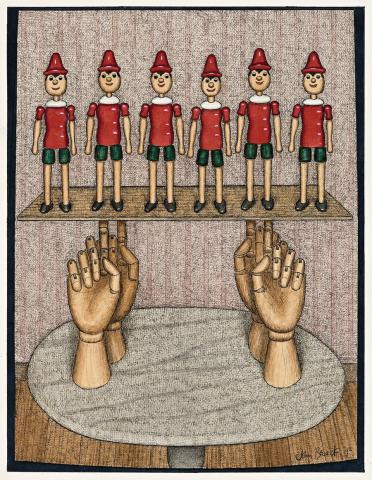PINOCCHIO ON THE HANDS, 1992
JOHN BRACK
watercolour, pen and ink on paper
65.0 x 50.0 cm
signed and dated lower right: John Brack 92
Private collection, Melbourne
Deutscher Fine Art, Melbourne, 20 May – 11 June 1994, cat. 11
The Pinocchio paintings were among the last works John Brack was to paint. The motif of the wooden puppet enshrined in childhood literature became his final reflection on the cycle of life and the theatre in which our lives play out. It was the next inevitable evocation of humanity after Brack's decade-long fascination with pencils and ink pens as a metaphor for the human condition. While the pencils tended to express a sense of the individual drowning in the homogenous crowd and thus relinquishing his or her personal characteristics, private thoughts or ambitions, the Pinocchio manikins suggested an ironic Brackian return to the human being. One interpretation suggests that 'The Pinocchio pictures celebrate the playful purity of the male self, before it has graduated to more dangerous adult games.'1
At play in these final paintings and drawings is a teetering sense of a destabilising threat to order. Pinocchio on the Hands, 1992 epitomises this quality with its straight row of six painted figures standing improbably on a ply panel held up only by the index figure of four wooden model hands. In a candid interview in 1991 he commented, 'I see the 20th-centuryworld as being in a state of precarious balance. Things are on the verge of toppling, but they haven't quite yet.'2 Sometimes Brack would place the dolls on artist's manikins such as observed in On Stage, 1992 (private collection) and in more playful guises tumbling across the round marble table top in Seven on the Table, 1990 (private collection). Helen Brack observed of these last works,'... he embarked upon a very tender and optimistic coda, using the marble oval with the full value of its preceding connotations, but using the manikins as a stylisation of people - and the hand, in a gesture of authority, the hand of God, God who is not God but is the Master, The Father, The Protector, the Prophet and Teacher from our ancient past. These he bound into the continuous and continuing family unit, the Mother connected to the stem of the table, the underneath of the stage on which we perform our lives.'3
1. Gott, T., A Question of Balance: John Brack 1974-1994, Heide Museum of Modern Art, Melbourne, 2000, p. 37
2. Hawley, J., Artists in Conversation, Slattery Media Group, Richmond, 2012, p. 167
3. Gott, T., op. cit., p. 39
LARA NICHOLLS
